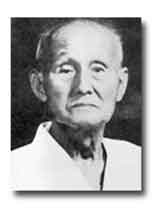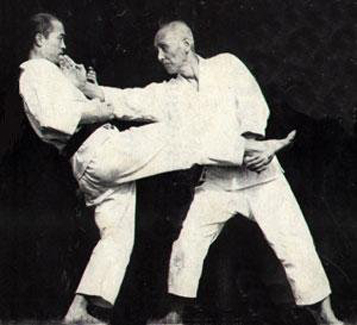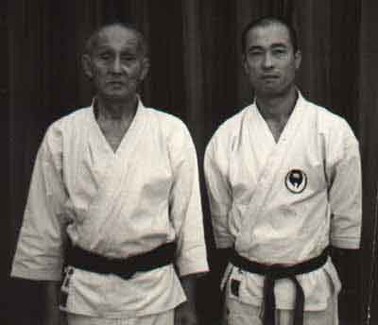Hironori Ohtsuka Sensei
Meijin, 10th Dan

Hironori Ohtsuka was born on 1st June 1892 in Shimodate City, Ibaragi, Japan. He was the first son and the second of four children of Dr. Tokujuro Ohtsuka, a doctor of medicine.
Ohtsuka Sensei was first introduced to martial arts by his great uncle, Chojiro Ebashi, a samurai warrior, who began teaching him jujitsu. This marked the starting point of his lifelong fascination with martial arts.
On 1st April 1897, Ohtsuka Sensei started school and studied Shindo Yoshin Ryu Jujitsu under the supervision of his father. Later, at age 13, he studied under Shinzaburo Nakayama Sensei, the third Grand Master of the style. Unlike other jujitsu schools at the time, Yoshin Ryu incorporated kicking and punching techniques along with throws, locks, and joint manipulation.
While studying at Waseda University (1910–1917), he continued training in Yoshin Ryu and explored various other jujitsu styles. Through this, he learned much about the body’s vital points—for both healing and attacking.

In 1922, at a sports festival in Tokyo, Ohtsuka Sensei witnessed a demonstration by Gichin Funakoshi, the Okinawan karate master now known as the Father of Modern Karate. Fascinated, Ohtsuka visited Funakoshi many times. Funakoshi was equally impressed with Ohtsuka’s dedication and agreed to teach him all he knew.
Ohtsuka also opened a medical practice focused on martial arts injuries. By age 30, he was a senior instructor in Shindo Yoshin Ryu and an assistant instructor at Funakoshi’s dojo.
By 1929, Ohtsuka Sensei was a registered member of the Japan Martial Arts Federation. At that time, Okinawan karate focused solely on kata. Ohtsuka believed this lacked the full spirit of budo, and he began experimenting by integrating judo, kendo, and aikido into his karate practice.
This led to the development of kumite (free fighting) in karate and the creation of a more fluid, practical, and Japanese-influenced style: Wado.
The Birth of Wado-Ryu
In 1934, two milestones occurred:
- Ohtsuka’s son (Ohtsuka the Second) was born.
- Wado-Ryu Karate was officially recognized as an independent style.
Ohtsuka left his medical career to pursue martial arts full-time. In 1938, he registered his unique style and was awarded the title Renshi-go. The Japan Martial Arts Federation recognized Wado-Ryu, and by 1939, the name “Wado-Ryu” was formally registered.
The style flourished—spreading through dojos and universities—and Ohtsuka became a prominent figure in Japan’s martial arts world.
Legacy and Global Expansion

In 1944, Ohtsuka was appointed Japan’s Chief Karate Instructor. His son began receiving direct instruction in Wado-Ryu in 1945.
Through the 1950s, Wado-Ryu remained largely within Japan. But in 1963, a three-man team (Arakama Sensei, Takashima Sensei, and Suzuki Sensei) traveled abroad to demonstrate Wado-Ryu. Their impact was significant, sparking global interest.
In 1966, Emperor Hirohito awarded Ohtsuka the prestigious title Kun Goto Suokuo Kyoku Jujitsu Shuo for his dedication to the promotion of karate.
In 1972, Ohtsuka received the rank of Meijin (10th Dan) — the first karateka ever to do so. This rank placed him among legends such as Kyuzo Mifune (Judo) and Hakuko Nakayama (Kendo).
Final Years
Ohtsuka continued to teach and guide the Wado world into the 1980s. In 1982, his son became the second Grand Master of Wado-Ryu, taking on his father’s name, Hironori.
Ohtsuka Sensei passed away peacefully on 19th January 1982.
His contributions and dedication to martial arts—especially Wado Karate—continue to be remembered and respected worldwide.
May he rest in peace.